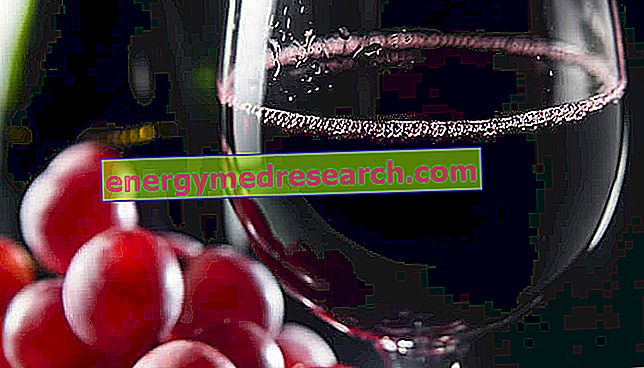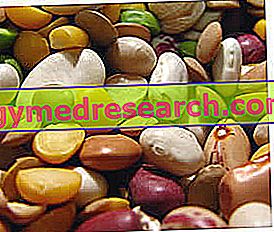Generality
Red wine is a typical alcoholic beverage of the Mediterranean area, obtained by fermentation of black grape must.
The production process, called vinification in red, involves the maceration of the grape skins together with the juice obtained by pressing them (initially yellowish); this allows the dilution of various molecules from the skins to the juice, including natural dyes called anthocyanins. In fact, the grapes with the dark pulp are very rare and, as soon as they are pressed, they give rise to an already red juice.

The color of the wine produced thanks to the vinification in red can vary from deep purple, for young wines, to burgundy with orange nuances, for aged wines.
Red wine is famous for its organoleptic properties (extremely variable depending on the type) and for its nutritional characteristics.
Containing ethyl alcohol, red wine cannot be considered a true "healthy" drink; on the other hand, thanks to the presence of phenolic antioxidants, it shows some health benefits.
Benefits
In general, when talking about the benefits of consuming red wine, the first molecule that comes to mind is resveratrol (on which there are dozens and dozens of approved scientific studies). This non-flavonoid phenol is attributed to antioxidant, antibacterial, antifungal, anti-tumor, anti-inflammatory and blood-thinning metabolic properties.
Under certain conditions, a glass of red wine a day could reduce the incidence of clot-related stroke by up to 50%. Probably, it is thanks to resveratrol and other polyphenols that the so-called "French Paradox" manifests itself: in the 1980s, some epidemiological studies revealed that - despite the abundance of saturated fatty acids and cholesterol in the diet - in France, the incidence of hypercholesterolemia and cardiovascular pathologies was lower than in other countries with a similar diet. On this apparent paradox it has been speculated that the consumption of red wine could protect against heart disease; today these evidences have been strongly questioned
Resveratrol also appears to protect the brain from cognitive decline linked to Alzheimer's disease.
Recently, when analyzing the composition of red wine, scientists at the "University of California at Davis" discovered another group of molecules that could fight excess cholesterol in the blood. These are the saponins, or foaming substances soluble in alcohol and able to bind cholesterol in the intestine (including that in the bile salts) reducing its absorption.
A study by the "Oregon States College of Agricultural Studies" has instead observed the reaction of guinea pigs to a nutritional regime rich in fat, with and without red wine extracts. All mice showed the same metabolic consequences typical of overweight sedentary humans, but those fed with red wine extract revealed less fat accumulation in the liver and lower glycemic levels. The molecule responsible for this reaction would be ellagic acid (also present in many vegetables and fruits, such as pomegranate), or a phenolic antioxidant able to hinder the accumulation of fat in cells and to oppose the development of new adipocytes.
What's more, red wine is also rich in quercetin . This flavonoid ( tetraoxiflavonol ) represents a metabolic inhibitor of some enzymes involved in the inflammatory response. The antioxidant functions of quercetin are restoration of tocopherols (vit E), detoxification of cells from superoxide and decrease in the secretion of nitric oxide during inflammation. Furthermore, according to the American Cancer Society, this flavonoid acts as a potent antitumor, especially in the colon.
Red wine is rich in so-called tannins, also known as proanthocyanidins; these phenolic compounds, responsible for the red pigment, are very famous for their potential beneficial action on a cardiovascular level (similar to that of the various molecules mentioned above).
Excess
It is clear that the set of the aforementioned molecules represents an extremely effective nutraceutical complex. However, as anticipated, being an alcoholic, red wine cannot be considered a real healthy drink. In fact, ethyl alcohol (which is a molecule that is harmful to the body) is a chemical element with a nervine action and an object of drug addiction for humans.
The side effects of alcohol include:
- Psychotropic action, which alters the normal function of the brain
- Irritation and inflammation of the mosses of the digestive tract (from the pharynx to the rectum)
- Increased chances of stomach acid, gastritis, gastroesophageal reflux, Barrett's esophagus, intestinal disorders and cancers
- Reduction of intestinal absorption, partly direct action, partly linked to irritation of the mucosa followed by diarrhea
- Vitamin B1 deficiency and increased probability of Wernicke's Encephalopathy
- Increased triglyceridemia
- Tendency to dehydration due to increased renal filtration
- Tendency to fatty liver steatosis, with the possibility of evolution in cirrhosis (associated with liver failure) and then in tumoral forms
- Toxic action towards other tissues and organs, such as the kidneys
- Blood glucose reduction, due to strong insulin stimulation
- Tendency to increase in fat mass, especially localized in the abdominal area (since alcohol cannot be used as an energy source, it is converted into fatty acids and deposited in adipose tissue in the form of triglycerides)
- Undesirable interactions with various drug therapies
- Contraindications for the fetus
- Sleep complications.
Furthermore, some phenolic substances in wine (such as tannins) exert a mild chelating function on certain nutrients (eg on iron); the same is true for saponins which, on the one hand, reduce the absorption of cholesterol, on the other hand also hinder that of various lipid nutrients.
How much red wine?
The acceptable alcohol ration fluctuates between 30 and 40g per day for healthy adults, while for the elderly it drops to 25-30g; the growing subjects should avoid it, as well as people who in some way could be damaged by the assumption (pathologies of the stomach, large obese etc.).
Red wine contains about 10-11g of ethyl alcohol per 100g, which is why its portions are 2 or at most 3 glasses of 125ml each.



